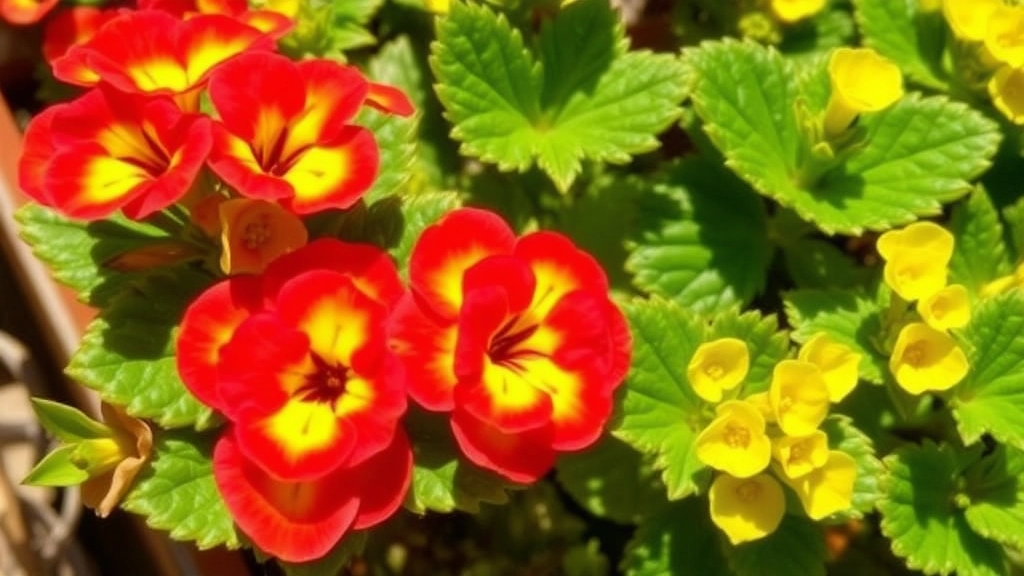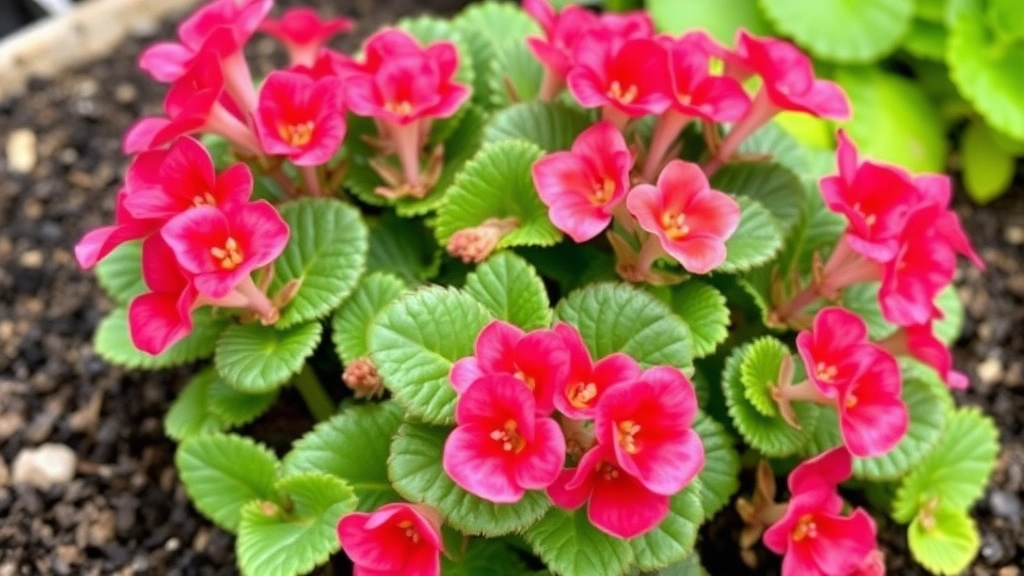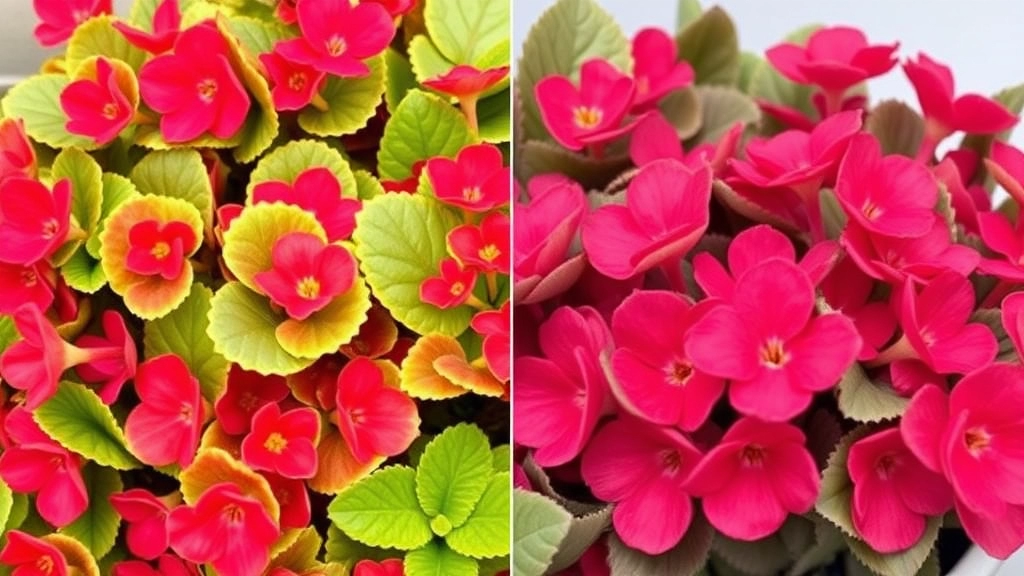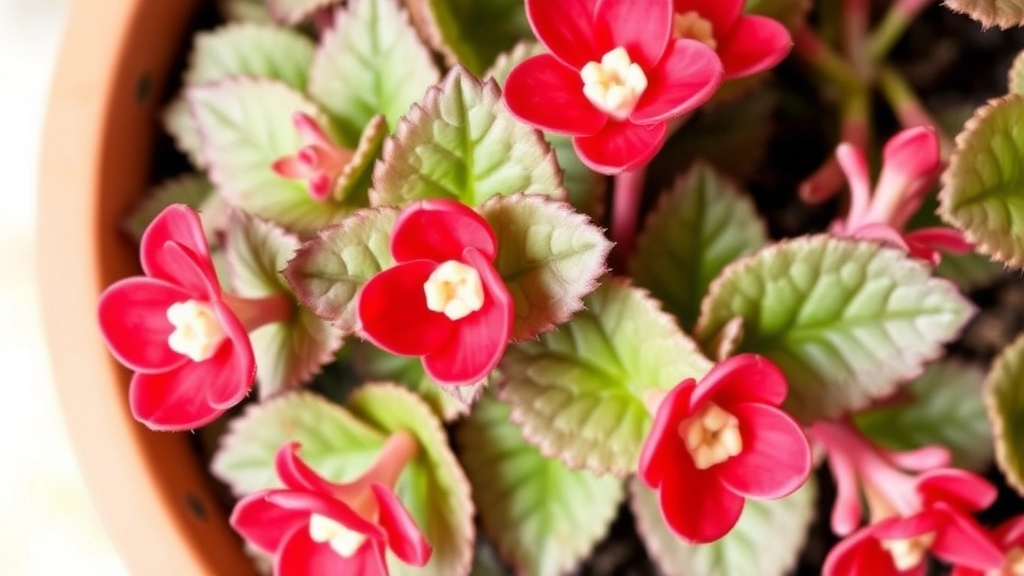Why Your Red Leaf Kalanchoe Changes Colour
Ever wondered why your Red Leaf Kalanchoe changes colour? It’s all about the care you give it. From sunlight exposure to watering habits, several factors influence those vibrant red hues. Let’s dive into how to keep your Kalanchoe thriving and beautifully red.
Key Factors for Thriving Kalanchoe
Understanding the right balance of light, water, and nutrients is key. Too much sunlight can stress the plant, turning the leaves red, while proper watering and soil conditions ensure healthy growth.
Tips to Maintain Your Kalanchoe
- Light: Ensure it receives the right amount of sunlight.
- Water: Water appropriately to avoid stress on the plant.
- Soil Conditions: Use well-draining soil for optimal growth.
Follow these tips to maintain your Red Leaf Kalanchoe in top shape and enjoy its stunning colours year-round.
Reasons for Kalanchoe Leaves Turning Red
Have you noticed your Kalanchoe leaves taking on a striking red hue? This can be both a beautiful and concerning sight for plant enthusiasts.
There are several reasons why Kalanchoe leaves might turn red, and understanding these factors can help you maintain the health of your plant.
1. Sunlight Exposure
Kalanchoe plants thrive in bright, indirect sunlight. However, too much direct sunlight can cause stress, leading to red pigmentation as a protective response.
- Tip: If your plant is in direct sunlight, consider moving it to a location with filtered light.
2. Temperature Fluctuations
Extreme temperatures can also cause Kalanchoe leaves to redden. If your plant experiences sudden changes in temperature, it may react by altering its leaf colour.
- Tip: Keep your Kalanchoe in a stable environment, ideally between 15°C and 25°C.
3. Nutrient Deficiencies
A lack of essential nutrients, particularly phosphorus, can result in red-tinged leaves. Kalanchoe requires a balanced fertiliser to flourish.
- Tip: Use a diluted fertiliser during the growing season for optimal results.
4. Watering Issues
Overwatering or underwatering can stress the plant, leading to colour changes. Kalanchoe prefers well-draining soil and should dry out between waterings.
- Tip: Check the soil moisture level before watering to prevent root rot. For more detailed advice, you can refer to this guide on causes and solutions for Kalanchoe leaves curling.
5. Natural Aging Process
Sometimes, the red colour is simply a part of the plant’s natural ageing process. Older leaves may change colour as they prepare to drop.
- Tip: Regularly prune dead or dying leaves to encourage new growth. You might also find this complete guide on caring for Kalanchoe after flowering useful for maintaining plant health.
How Sunlight Affects Kalanchoe Coloration

Ever wondered why your Kalanchoe leaves are turning a vibrant red?
It’s all about sunlight!
Kalanchoe plants are like little solar panels, soaking up rays to thrive.
But the amount and intensity of sunlight they receive can dramatically change their leaf colour.
Sunlight and Colour Changes
- Direct Sunlight: When Kalanchoe gets a good dose of direct sunlight, especially in the morning, it can lead to those striking red hues. This is a sign of stress, but in a good way! The plant is essentially saying, “I’ve got enough light to thrive, and I’m showing off my vibrant self.”
- Low Light: On the flip side, if your Kalanchoe isn’t getting enough light, it might turn a dull green. Not exactly the showstopper you want, right? A lack of sunlight can lead to weak growth and a less-than-appealing appearance.
- Filtered Light: If you can’t provide full sun, filtered or indirect light works too. Your Kalanchoe will still be healthy, though it may not flaunt those fiery red leaves as boldly.
Finding the Right Balance
To keep your Kalanchoe looking its best, consider these tips:
- Location: Place your plant near a south or west-facing window for optimal sunlight.
- Rotation: Rotate your plant occasionally to ensure all sides get equal light exposure.
- Monitoring: Watch for signs of too much or too little sun. If the leaves start to burn or fade, adjust accordingly.
Best Watering Practices for Healthy Kalanchoe Growth
As we explore the vibrant world of Kalanchoe care, watering practices stand out as a crucial factor influencing the health and appearance of these stunning plants.
Soil and Nutrient Requirements for Kalanchoe

When it comes to ensuring your Kalanchoe thrives, soil and nutrients play a pivotal role. You might be wondering, “What type of soil does my Kalanchoe need?” or “How can I provide the right nutrients?” Let’s dive into these essential aspects.
Ideal Soil Type
Kalanchoe plants prefer well-draining soil to prevent root rot. Here are some key points to consider:
- Cactus Mix: A pre-made cactus or succulent mix is often ideal.
- DIY Mix: You can create your own by combining:
- 50% potting soil
- 25% perlite
- 25% sand
This blend ensures adequate drainage while retaining some moisture.
Nutrient Requirements
Kalanchoe doesn’t require heavy feeding, but providing the right nutrients can boost its growth and colour. Here’s what you should know:
- Fertiliser: Use a balanced, water-soluble fertiliser diluted to half strength.
- Frequency: Feed your Kalanchoe every 4-6 weeks during the growing season (spring and summer).
- Organic Options: Consider using compost or fish emulsion for a natural nutrient boost.
pH Levels
The ideal pH for Kalanchoe soil is between 6.0 and 7.0. Testing your soil can help you maintain this balance, ensuring optimal nutrient absorption.
Signs of Nutrient Deficiency
Keep an eye out for these signs:
- Yellowing Leaves: May indicate nitrogen deficiency.
- Stunted Growth: Could be a sign of insufficient nutrients.
By addressing these issues promptly, you can keep your Kalanchoe healthy and vibrant.
Ideal Temperature Range for Preventing Stress in Kalanchoe
Are you noticing your Kalanchoe showing signs of stress? One critical factor to consider is temperature.
Kalanchoe thrives in a specific temperature range that helps maintain its vibrant health and stunning appearance.
Optimal Temperature Range:
- Daytime: 20°C to 25°C (68°F to 77°F)
- Nighttime: 10°C to 15°C (50°F to 59°F)
Staying within this range is essential for preventing stress and ensuring your plant remains lush.
Signs of Temperature Stress:
- Leaves may become limp or droopy.
- Colour changes, such as reddening or yellowing.
- Stunted growth or wilting.
To keep your Kalanchoe happy, consider these tips:
- Avoid Sudden Temperature Changes: Rapid fluctuations can shock your plant.
- Keep Away from Drafts: Ensure your plant isn’t near open windows or air conditioning vents.
- Monitor Seasonal Changes: Adjust your care routine as temperatures shift throughout the year.
If you’re growing your Kalanchoe indoors, a stable environment is key.
Example: I once had a Kalanchoe that thrived during summer but struggled in winter. By placing it in a warmer spot, it bounced back beautifully.
Maintaining the right temperature not only prevents stress but also promotes blooming. For more detailed tips on how to keep your Kalanchoe flowering, check out our guide on why your Florist Kalanchoe is not flowering.
Additionally, if you are growing your Kalanchoe outdoors and are concerned about temperature changes, our guide on planting Kalanchoe outside in the UK offers useful insights.
Popular Kalanchoe Varieties with Red-Tinted Leaves

So, you’ve noticed your Kalanchoe turning a beautiful shade of red and you’re curious about which varieties are known for this striking coloration.
Here are some popular Kalanchoe varieties that flaunt red-tinted leaves:
- Kalanchoe Blossfeldiana: This classic beauty often showcases vibrant red edges on its leaves. It’s a popular choice for indoor gardens and adds a splash of colour to any space.
- Kalanchoe thyrsiflora: Also known as the “paddle plant,” this variety has thick, rounded leaves that can take on a stunning red hue when exposed to bright sunlight.
- Kalanchoe luciae: The “flapjack” plant is another favourite. Its leaves can turn a deep red, especially in the cooler months, making it a real showstopper.
- Kalanchoe ‘Copper Spoons’: This variety boasts unique, spoon-shaped leaves that develop a reddish tint when stressed, giving it a distinctive look.
- Kalanchoe ‘Pink Butterflies’: As the name suggests, this one features lovely pink and red tones that can brighten up any collection.
These varieties not only look great, but they also thrive with the right care.
What’s the secret to keeping them vibrant?
Well, it all starts with understanding their light and watering needs.
As we explore the vibrant world of Kalanchoe care, it’s essential to address the common challenges that can arise. Understanding these issues can help you maintain the stunning appearance of your Kalanchoe and ensure it thrives.
### Common Issues
– **Leaf Dropping**
If your Kalanchoe is shedding leaves, it could be a sign of stress.
*Causes:* Overwatering, underwatering, or sudden temperature changes.
*Solution:* Adjust your watering schedule and ensure the plant is in a stable environment. For more detailed solutions, check out [how to fix drooping Kalanchoe leaves](https://planthq.org/how-to-fix-drooping-kalanchoe-leaves-causes-and-solutions/).
– **Pest Infestation**
Pests like mealybugs and aphids can wreak havoc on your Kalanchoe.
*Signs:* Sticky residue, visible pests, or webbing on the plant.
*Solution:* Use insecticidal soap or neem oil to treat the infestation.
– **Discoloration of Leaves**
Besides turning red, leaves may become yellow or brown.
*Causes:* Nutrient deficiencies or excessive sunlight.
*Solution:* Check your soil quality and adjust light exposure accordingly.
– **Stunted Growth**
If your Kalanchoe isn’t growing as expected, it might be lacking essential nutrients.
*Causes:* Poor soil quality or insufficient fertilisation.
*Solution:* Use a balanced fertiliser during the growing season.
– **Root Rot**
This is a serious issue often caused by overwatering.
*Signs:* Wilting despite wet soil, foul smell from the pot.
*Solution:* Remove the plant, trim away rotten roots, and repot in fresh, well-draining soil.
### Preventative Measures
To keep your Kalanchoe healthy, consider these tips:
– **Regular Checks:** Inspect leaves and soil weekly for signs of issues.
– **Proper Watering:** Stick to the “soak and dry” methodâwater thoroughly, then let the soil dry out before the next watering.
– **Optimal Lighting:** Ensure your plant gets bright, indirect sunlight to avoid stress.
By staying proactive and addressing these common issues, you can ensure your Kalanchoe remains a vibrant addition to your home. For more comprehensive care tips, you might find our [ultimate guide to fuzzy Kalanchoe care](https://planthq.org/ultimate-guide-to-fuzzy-kalanchoe-care-tips/) helpful.
FAQs About Red Leaf Kalanchoe
Why are my Kalanchoe leaves turning red?
The vibrant red coloration in Kalanchoe leaves is primarily due to exposure to direct sunlight. This color change is a sign that the plant is thriving and receiving enough light.
Can Kalanchoe leaves turn red without direct sunlight?
Yes, but the red hues may not be as intense. Filtered or indirect light can still keep the plant healthy, though the coloration might be less vibrant.
What type of soil is best for Kalanchoe plants?
Kalanchoe plants prefer well-draining soil. A pre-made cactus or succulent mix is ideal, or you can create your own mix using 50% potting soil, 25% perlite, and 25% sand.
How often should I fertilize my Kalanchoe?
Fertilize your Kalanchoe every 4-6 weeks during the growing season (spring and summer) using a balanced, water-soluble fertilizer diluted to half strength.
What are signs that my Kalanchoe needs more nutrients?
Signs of nutrient deficiency include yellowing leaves, which may indicate nitrogen deficiency, and stunted growth, which could be a sign of insufficient nutrients.
Which Kalanchoe varieties are known for red-tinted leaves?
Popular Kalanchoe varieties with red-tinted leaves include:
- Kalanchoe Blossfeldiana
- Kalanchoe thyrsiflora (paddle plant)
- Kalanchoe luciae (flapjack plant)
- Kalanchoe ‘Copper Spoons’
- Kalanchoe ‘Pink Butterflies’
How can I maintain the vibrant red color in my Kalanchoe leaves?
To keep the red coloration vibrant, ensure your Kalanchoe receives adequate sunlight, ideally direct morning sunlight. Also, maintain proper soil and nutrient conditions.
What is the ideal pH level for Kalanchoe soil?
The ideal pH for Kalanchoe soil is between 6.0 and 7.0. Testing your soil can help maintain this balance, ensuring optimal nutrient absorption.
How can I prevent my Kalanchoe leaves from burning?
If the leaves start to burn, it may be due to too much direct sunlight. Adjust the plant’s location to provide filtered or indirect light to prevent leaf burn.
What are the watering needs for Kalanchoe?
Kalanchoe plants prefer to be watered thoroughly but infrequently. Allow the soil to dry out between waterings to prevent root rot.
References
-
Kalanchoe Plant Care – Gardening Know How
-
How to Grow Kalanchoe Indoors – The Spruce
-
Kalanchoe – House Plants Expert
